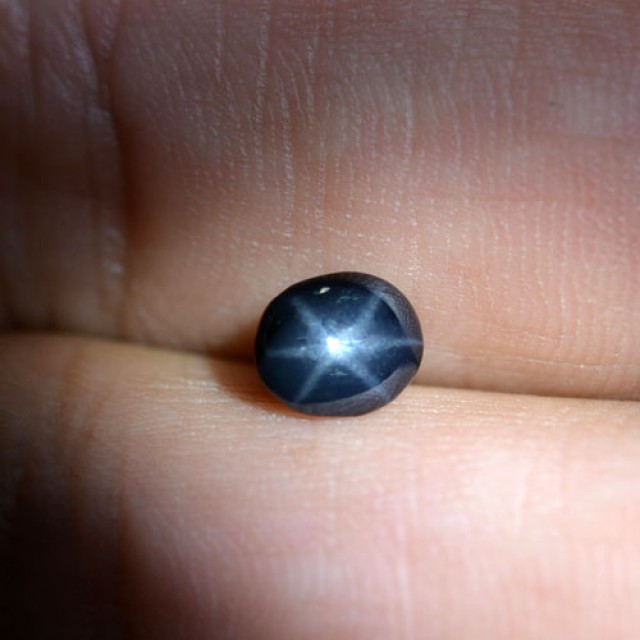
尖晶石的含义、价值、价格和特性
尖晶石是一种美丽的宝石,颜色多样,最常见的是红色、紫色和蓝色。尖晶石的坚固性和鲜艳的色彩可与蓝宝石和红宝石等珍贵宝石媲美,但由于知名度较低,价格也较低。
几个世纪以来,尖晶石宝石一直被忽视和低估,主要是因为被误认为是红宝石,并且是最早合成的宝石之一。
然而,这并不能掩盖尖晶石宝石自成一派、值得关注的事实。
数十年来,我们深耕宝石行业,对那些被低估的宝石略知一二。在我们看来,每颗宝石都值得被赋予光彩。正因如此,我们精心打造了这份关于尖晶石的全面指南,从其特性、价格到历史和能量,一一为您揭秘。

关于尖晶石
尖晶石是一种半宝石,尽管历史上它曾被误认为是红宝石和蓝宝石。有些尖晶石甚至被用来模仿彩色钻石。
尖晶石的身份混淆导致这种宝石有许多绰号:
Candite(产自斯里兰卡坎迪的尖晶石)
辉石
Rubicelle(黄色至橙红色尖晶石)
尖晶石/尖晶石
红宝石尖晶石
长期以来,尖晶石被认为是蓝宝石和红宝石的原因之一是它们被错误地归类为刚玉,而刚玉是一种与尖晶石一起大量开采的矿物。
与众多蓝宝石一样,尖晶石也散发着各种色彩,从浅粉色、淡紫色、淡紫色,到浓郁鲜艳的红色、蓝色、橙色,有时甚至还有黑色。尖晶石之所以持续受到人们的青睐,是因为它天然饱和的色泽。
您可能有兴趣知道,尖晶石是八月的诞生石,2016年加入橄榄石的行列。在占星术中,尖晶石是白羊座、天蝎座、金牛座和射手座的幸运石。
尖晶石规格和特性
尖晶石是一种单独的镁铝氧化物矿物,化学式为MgAl2O4,但它也属于同名的尖晶石亚族,该亚族本身属于尖晶石超族。尖晶石亚族包含的氧化铝元素,其化学式中也含有亚铁、锰、镁、钴、锌或镍。
为了清晰起见,我们将尖晶石单独称为“尖晶石”,并将尖晶石亚族的成员称为“尖晶石族”矿物。尖晶石是该族中唯一常被用作宝石的成员。
尖晶石中常见的杂质包括钛、铁、锌、锰和钙。
尖晶石与锌尖晶石(中间成员称为锌尖晶石)形成一个固溶体系列。它还与铁尖晶石和镁铬铁矿形成另外两个系列。
从晶体形态来看,尖晶石晶体通常呈八面体;很少形成十二面体或立方体。形状完美的八面体尖晶石在缅甸被称为“天使切割”。这种矿物也可能以块状、致密状或颗粒状形态出现。
尖晶石特性列表
莫氏硬度:7.5-8
颜色:红色、粉色、黑色、紫色、绿色、橙色、灰色或棕色等各种色调;很少是无色的;绝不会是纯黄色或纯绿色
晶体结构:等轴(立方)
光泽:玻璃光泽或亚金刚石光泽
透明度:透明至不透明(通常半透明至透明)
折射率:1.712-1.747
密度:3.57-4.10
解理:无
断口:贝壳状
条痕:白色或灰白色
发光:有时会出现荧光、磷光和X射线颜色,因颜色而异:
红色至粉色尖晶石:在长波紫外光、短波紫外光和 X 射线下呈现红色
蓝色尖晶石:无
紫色尖晶石:长波紫外线下呈红色,X射线下呈淡紫色
浅蓝色和紫色尖晶石:长波紫外线和X射线下呈现绿色
无色和浅绿色尖晶石:在长波紫外线下有时呈橙色/红色
橙色尖晶石:在短波紫外光下为红色或橙色,有时在长波紫外光下为红色或橙色
多色性:无
双折射:无
分散性:0.020(中等)
光学效应:有时有猫眼效应、4 射线或 6 射线星光、颜色变化
尖晶石的种类
回答“尖晶石有哪些种类”可以有几种不同的解释。例如,尖晶石亚族的成员、尖晶石的各个品种,以及不同尖晶石宝石的商品名。
我们将从尖晶石子组开始。
 上图:来自阿根廷的 1.34 克拉刻面 Gahnite | 图片来源:Kay Günther / G-Empire The World of Gems / http://www.g-empire.de/
上图:来自阿根廷的 1.34 克拉刻面 Gahnite | 图片来源:Kay Günther / G-Empire The World of Gems / http://www.g-empire.de/
尖晶石亚组矿物
尖晶石亚组包含 30 个成员,其中 26 个经过 IMA 批准,因此我们仅介绍一些值得注意的成员:
铬铁矿:氧化铁铬;棕色、棕黑色或黑色带深棕色条纹;原生铬矿;高折射率(2.08-2.16)和密度(4.50-4.80)
富兰克林石:氧化锌铁;黑色、红棕色或棕色;重要的锌矿石;RI 值(2.36)和密度(5.07-5.22)非常高
锌铝石:氧化锌铝;深绿色、蓝绿色、蓝色、黄色、棕色、灰色或黑色;相对折射率 (1.79-1.80) 和密度 (4.62) 相当高
锰尖晶石:(又名“锰尖晶石”)锰铝氧化物;黑色、红棕色、红色或黄色;相对折射率 (1.923) 和密度 (4.30) 相当高
黑锰矿:二价和三价氧化锰;棕黑色、灰色、蓝灰色或棕灰色;研究其多种潜在技术用途;高折射率(2.462-2.152)和密度(4.83-4.85)
铁铝尖晶石:氧化铁铝;深绿色至黑色,带有灰绿色至绿色条纹;折射率 (1.80-1.83) 和密度 (4.39) 相当高
皮科特石:亚种(未经 IMA 认可),含镁和铬的铁铝尖晶石;深绿色、黑色或棕色
锌锰矿:氧化锌锰,与黑锰矿非常相似;黑色或红黑色;四方晶系;折射率 (2.14-2.34) 和密度 (5.18) 非常高
雅各布石:氧化镁铁;黑色或灰色;高密度(4.76)
磁铁矿:氧化亚铁和三价铁;浅灰色至铁黑色;磁性且重要的铁矿石;RI(2.52)和密度(5.2)非常高
 上图:方解石上的锡兰石(尖晶石品种)晶体;安塔尼莫拉公社,安博文贝区,安德罗伊地区,图莱尔省(图利亚拉),马达加斯加 |图片来源:Géry PARENT, CC-BY-SA-4.0
上图:方解石上的锡兰石(尖晶石品种)晶体;安塔尼莫拉公社,安博文贝区,安德罗伊地区,图莱尔省(图利亚拉),马达加斯加 |图片来源:Géry PARENT, CC-BY-SA-4.0
尖晶石品种
接下来,我们有各种不同的尖晶石:
锡兰石:含铁(Fe2+),几乎不含三价铁(Fe3+);颜色为非常深的灰色、蓝色或黑色;注意:该名称有时会被错误地用于锡兰石
铁镁铝榴石:同样是含铁元素(Fe2+),但镁铁比例较低(1:3);颜色相似,但晶体形态更复杂,如十二面体-八面体组合
镁铬铁矿:含铬品种
氯尖晶石:富含三价铁的品种;因铜杂质而呈草绿色
碱性脊柱l:碱性品种,含 1.38% 氧化钠 (Na2O) 和 1.31% 氧化钾,1922 年由瑞典报道;黑绿色
尖晶石商品名
历史上或现代对各种尖晶石使用的一些昵称(其中许多都是误称)包括:
Rubicelle :黄色至橙红色尖晶石
红宝石尖晶石:半透明、宝石级红色尖晶石
紫翠玉尖晶石:日光下呈灰蓝色,白炽灯下呈紫色
绝地尖晶石:产自缅甸的明亮电红色或霓虹粉色尖晶石
巴拉斯红宝石:玫瑰红尖晶石的历史术语
铁铝榴石尖晶石:天然紫色尖晶石
现在,让我们暂时抛开矿物学和分类,来一窥尖晶石的形而上学方面和传奇历史。
 上图:紫粉色尖晶石戒指,镶嵌钻石
上图:紫粉色尖晶石戒指,镶嵌钻石
尖晶石的含义
从词源学角度来看,尖晶石的含义可能源自拉丁语“ spina ”,意为“刺”。有人认为,比利时医生让·德梅斯特(Jean Demeste)之所以选择这个名字,是因为这种宝石可以形成尖锐的八面体晶体,让人联想到植物上的刺。然而,这种刺状的尖晶石晶体并不常见。因此,尖晶石的名字本身更像是一个传说,而非事实。
考虑到这种宝石的古老起源,以及早期对宝石的分析只是推测而非科学,这并非不可能。
“尖晶石”名称的另一个可能来源是古希腊语spinthḗr ,意为“火花”,源于这种宝石的鲜艳色彩。
遗憾的是,自从发现许多著名的红宝石其实是尖晶石以来,尖晶石一直被称为“大骗子”。但值得庆幸的是,尖晶石凭借其高光泽、硬度和亮度,终于被人们视为一种高级珠宝宝石。
尖晶石如今象征着什么?
从精神层面来说,尖晶石象征着希望、感恩、灵感、重生和激情。有人认为,在越南民间传说中,蓝色尖晶石是月亮女神的眼泪。其他文化则使用尖晶石来抵御邪眼,例如 哈姆萨之手。
 上图:巴塞尔市委托创作的《三兄弟》珠宝微绘,约1500年,由三颗长方形红色尖晶石组成,中间镶嵌四颗白色珍珠和一颗深蓝色钻石。| 图片来源:原画作者不详。摄影:Peter Portner,巴塞尔历史博物馆, CC-BY-SA-4.0
上图:巴塞尔市委托创作的《三兄弟》珠宝微绘,约1500年,由三颗长方形红色尖晶石组成,中间镶嵌四颗白色珍珠和一颗深蓝色钻石。| 图片来源:原画作者不详。摄影:Peter Portner,巴塞尔历史博物馆, CC-BY-SA-4.0
尖晶石的历史
我们已经讨论过很多关于尖晶石宝石的各种误解。事实上,几个世纪以来,尖晶石一直生活在红宝石的阴影下。它们最终是如何成为一种独特的宝石的呢?
直到 1783 年,法国矿物学家 Jean Baptiste Louis Rome de Lisle 才最终发现刚玉(红宝石和蓝宝石的母石)和尖晶石之间的可识别差异。
随着这一发现,宝石界掀起了一连串的波澜。仔细观察所有著名的红宝石,人们发现一批享有盛誉甚至皇室级别的“红宝石”其实是尖晶石!
事实证明,尖晶石已经存在了几个世纪,至少从中世纪开始,它就被欧洲称为来自印度的“巴拉斯红宝石”。
 上图:奥古斯特·舒夫特(August Schoefft)绘制的谢尔·辛格大君(Maharaja Sher Singh)画作中帖木儿红宝石的细节,约1841-42年 | 图片来源:英国旁遮普遗产协会(UKPHA)发布的题为《谢尔·辛格大君佩戴光之山钻石》(Maharaja Sher Singh Wearing the Koh-I-Noor Diamond c1841-42)的视频演示,由图尔收藏(Toor Collection)的达文德·辛格·图尔(Davinder Singh Toor)主讲,属于公共领域
上图:奥古斯特·舒夫特(August Schoefft)绘制的谢尔·辛格大君(Maharaja Sher Singh)画作中帖木儿红宝石的细节,约1841-42年 | 图片来源:英国旁遮普遗产协会(UKPHA)发布的题为《谢尔·辛格大君佩戴光之山钻石》(Maharaja Sher Singh Wearing the Koh-I-Noor Diamond c1841-42)的视频演示,由图尔收藏(Toor Collection)的达文德·辛格·图尔(Davinder Singh Toor)主讲,属于公共领域
尖晶石被误认为是红宝石
以下是一些被误认为是红宝石的尖晶石的著名例子:
帖木儿红宝石(又名Khiraj-i-alam,意为“献给世界的礼物”)是一颗 352.5 克拉的抛光红色尖晶石,曾由几位印度和波斯贵族所有,后于 1849 年被英国东印度贸易公司从 Duleep Singh 手中夺走,并镶嵌在一条送给维多利亚女王的项链上。
黑王子红宝石,一颗重达 170 克拉的红色尖晶石凸圆形宝石,镶嵌在英国帝国皇冠上,但它的起源可以追溯到 14 世纪中期,当时卡斯蒂利亚的彼得(又名唐佩德罗)从格拉纳达酋长国的阿拉伯穆斯林王子阿布·萨伊德手中夺走了它。
俄罗斯帝国皇冠,顶部十字架下方镶嵌着一颗重达 398.72 克拉的红色尖晶石,于 1762 年首次为叶卡捷琳娜大帝打造,最后一次由尼古拉二世在 1896 年至 1917 年间佩戴
萨玛利亚尖晶石,一颗重 500 克拉的不规则形状红色尖晶石(世界上最大的尖晶石),由波斯国王纳迪尔沙于 18 世纪捕获,成为伊朗皇冠珠宝的一部分
19世纪至今
1812年,弗里德里希·莫斯公布了硬度等级,劣质尖晶石的硬度被降级至7.5-8级。由于红宝石的硬度为9级,仅次于钻石,尖晶石立即被归类为不值得珍视的“冒牌宝石”。
由于皇室皇冠上的宝石被揭露为尖晶石,这种宝石的声誉受损,一度被降为B级宝石。尽管尖晶石过去曾饱受诟病,但它最终还是重获新生,在尊贵的宝石界占据了一席之地。
绚丽多彩的80年代,珠宝风潮再度兴起,尖晶石也一度成为人们关注的焦点。如今,尖晶石不再被视为伪珠宝,而是因其内在价值和美感而备受推崇,珠宝设计师们也越来越多地选择尖晶石,而非红宝石和蓝宝石。

尖晶石的治疗特性
尖晶石具有哪些疗愈功效?与其他红色宝石一样,尖晶石火红的色彩象征着激情和长寿。尖晶石的精神寓意是希望、喜悦和活力的体现。
身体康复
从生理学角度来看,尖晶石被认为能够舒缓炎症,尤其是神经炎症,其振动频率具有镇静作用。水晶治疗师也推荐尖晶石用于增强耐力,缩短伤病恢复时间。
情绪疗愈
从精神层面来说,尖晶石有益于心灵,能够提升智力。尖晶石还能平衡情绪,赋予人们自我抚慰和治愈个人创伤的力量。如果您容易受到不良影响,尖晶石可以作为一道保护屏障,抵御负面影响和能量。
脉轮疗愈
脉轮疗愈是通过打开阻塞的能量中心(脉轮)来缓解负面身体或情绪症状,让能量正常流动的过程。大多数宝石只能打开一两个脉轮,而尖晶石却能打开并平衡所有七个脉轮!这使得平衡的能量从你的基础脉轮(掌管基本需求和稳定性的中心)流向你的顶轮(掌管精神提升的中心)。

尖晶石宝石特性
与许多其他宝石一样,尖晶石的价值和分级基于4C标准:颜色、切工、净度和克拉重量。虽然这些因素很重要,但如果您打算购买尖晶石宝石,最好了解其处理方法,并警惕市面上大量存在的合成材料。
颜色
众所周知,天然尖晶石几乎有各种颜色,除了纯绿色和纯黄色。鉴于它们与蓝宝石和红宝石的联系,最受欢迎的尖晶石颜色是红宝石色和蓝宝石色也就不足为奇了。
红色或蓝色尖晶石纯度高(几乎没有底色),且饱和度适中,价值最高。事实上,任何底色较少、饱和度适中的尖晶石,其价值都远高于同色系中底色过深、过浅或过于暗淡的尖晶石。天然无色尖晶石非常稀有,备受追捧。
更实惠的尖晶石颜色包括黑色、灰色、紫色以及淡粉色、淡紫色或蓝色。
尖晶石具有异色性,这意味着它们在最纯净的状态下是无色的,并会因不同的杂质而呈现出不同的色调。无色尖晶石实际上非常罕见,不同的杂质(或杂质组合)会形成更为人熟知的尖晶石颜色:
粉色和红色:铬或铬和钒,含微量铁,导致颜色变深
橙色:含有大量钒和/或铬和铁
灰蓝色、浅蓝色和淡紫色:铁
紫色:铬和铁
鲜艳的绿蓝色至紫蓝色:钴或钴和铁
黑色:氧化镁、氧化锌或含有大量铁、钒和铬等元素
蓝绿组合:电子电荷转移
此外,一些尖晶石可以自然变色,在日光或荧光灯下会从紫蓝色变为白炽灯下的紫色。
垫形切割变色尖晶石的潜在图像:
 上图:枕形切割多面变色尖晶石
上图:枕形切割多面变色尖晶石
切
大多数宝石级尖晶石原石都是刻面的。由于其坚固耐用和硬度高,这些尖晶石宝石的形状和尺寸各异。由于折射率高(意味着亮度更高)且净度极高,最受欢迎的切割方式包括圆形明亮式切割、祖母绿式切割、垫形切割和椭圆形切割。
这些形状的每克拉价格差别不大,但祖母绿切割尖晶石往往价格稍高一些,因为它们通常使用更多的原石,而且更难做好,并且需要一块高清晰度的尖晶石。
有趣的是,尖晶石天然具有八面体(八边形)晶体,宝石切割师通常会将宝石切割成八面体,看起来像八边形的钻石形状,以最佳地展示晶体。
对于较为稀有的颜色,宝石切割师可能会选择产量最高的刻面切割(保留最大的克拉重量,而不会切掉太多的原石)。
净度较低的尖晶石可以切割成雕刻品、珠子或凸圆形宝石。具有星光或猫眼等光学现象的尖晶石必须切割成凸圆形宝石才能展现其效果。
 上图:SI(微内含级)蓝紫色刻面尖晶石
上图:SI(微内含级)蓝紫色刻面尖晶石
明晰
在彩色宝石净度等级标准中,尖晶石属于 II 型宝石,这意味着肉眼可见的微小内含物很常见,但高品质宝石在没有放大的情况下不会有可见的内含物(又称“肉眼无瑕”)。
通常,可见的内含物会降低尖晶石的价值,但它们对于鉴别天然和合成尖晶石也很重要。
天然尖晶石中常见的内含物有:
指纹(成排的微小、有棱角的八面体负晶体)
针状(通常为金红石)
锆石(有时周围有光晕或暗环)
其他晶体(例如黄铁矿、磷灰石、赤铁矿、榍石、橄榄石、方解石、闪石)
亮片(径向拉伸裂纹)
丝(另一种晶体的非常细的线状针,通常是金红石,形成六边形图案或以 60° 或 120° 角接触)
负晶体(可以是单相、双相或三相)
铁锈(通常在边缘)
羽毛状(晶格中类似羽毛的微小裂纹)
某些内含物图案可产生“猫眼”(猫睛光)或“星光”(星彩)效果,从而提升宝石的价值。通常,这些内含物是排列整齐的榍石或金红石针状体,形成单条光线(猫眼光)或多条光线(星光)。
克拉重量和尺寸
尖晶石原石的尺寸非常巨大,一些最著名的尖晶石宝石甚至重达数百克拉。但很少有宝石级尖晶石能够被切割成超过5克拉的宝石。超过2克拉,其品质(例如净度和颜色)往往会下降。
在其他所有因素相同的情况下,尖晶石的克拉单价在1克拉、2克拉、5克拉和8克拉时会大幅上涨。例如,如果4克拉尖晶石的颜色、切工、净度等更佳,那么它的克拉单价可能会远高于8克拉尖晶石。
 上图:热处理蓝色尖晶石
上图:热处理蓝色尖晶石
治疗
大多数尖晶石宝石未经任何处理。偶尔会进行一些处理,包括加热和/或裂缝填充。
热处理可以增强颜色(但如果处理不当,颜色可能会变差),同时提高具有亚微观光散射内含物的尖晶石的清晰度。
有些尖晶石会进行裂缝填充处理(使用折射率与尖晶石相近的油或树脂填充裂缝),但大多数尖晶石的净度足够好,无需进行这种处理。此外,裂缝填充并非永久性处理。
最近,一些经过扩散处理的尖晶石崭露头角。美国宝石学院 (GIA) 于 2023 年 2 月报告了亮绿色至蓝色钴或镍扩散尖晶石。虽然扩散处理是永久性的,但人工颜色仅存在于表面,因此抛光或切割宝石才能展现其真实颜色。
 上图:银质吊坠,镶嵌合成“海蓝”尖晶石 | 图片来源:Gosiko, CC-BY-SA-3.0
上图:银质吊坠,镶嵌合成“海蓝”尖晶石 | 图片来源:Gosiko, CC-BY-SA-3.0
合成尖晶石
尖晶石是最早合成的宝石之一。最早是在19世纪中期偶然合成的,采用助熔剂法;之后在20世纪20年代,人们开始有意通过火焰熔融法进行商业销售。第三种合成尖晶石的方法是提拉法。
合成尖晶石的优势在于价格更实惠,更容易获得稀有颜色的尖晶石。无色合成尖晶石就是一个常见的例子。
由于合成尖晶石种类繁多,因此出现了各种商品名称:
Strongite :合成尖晶石的广义术语
辐射:蓝色合成尖晶石
火焰尖晶石:亮橙色或红橙色合成尖晶石
Perigem :淡黄色合成尖晶石
绿柱石或玫瑰锆石:玫瑰色合成尖晶石
Corundolite、Alumag、Lustergem 或 Magalux :无色、富铝合成尖晶石
Emerada 或 Erinide :黄绿色合成尖晶石
Dialite 或 Carnegiegem :以钛酸锶为基底的无色合成尖晶石双晶
天然尖晶石可以模仿红宝石和蓝宝石等宝石,而合成尖晶石也可以模仿以下宝石:
在实验室中制造尖晶石的方法有很多种,但尖晶石是如何自然形成的呢?
 上图:刻面级尖晶石原石
上图:刻面级尖晶石原石
尖晶石的形成和来源
尖晶石通常形成于区域变质或接触变质作用,压力和热量会改变不纯的石灰岩及其内部的矿物。热量和压力会将石灰岩转化为白云石大理石,并将其中的元素或矿物转化为尖晶石。
尖晶石矿物也存在于橄榄岩等火成岩和其他变质岩(如夕卡岩和花岗斑岩)中。
有时,尖晶石会直接在母岩中被发现,但更常见的情况是,它会脱落,被冲积到冲积矿床中。尖晶石到达这些冲积矿床时,其风化作用有助于矿工更容易地识别宝石级尖晶石。
有趣的是,尖晶石经常与刚玉(红宝石和蓝宝石)一起发现。其他常见的伴生矿物包括:
采矿地点
尖晶石在世界各地有许多产地,但宝石级尖晶石的三大产地是缅甸、斯里兰卡和阿富汗。
其他重要的宝石级尖晶石原石来源包括:
柬埔寨
马达加斯加
塔吉克斯坦
坦桑尼亚
泰国
越南
美国
平均而言,缅甸的尖晶石宝石通常最昂贵,其次是斯里兰卡,然后是泰国。
 上图:深红色缅甸尖晶石
上图:深红色缅甸尖晶石
尖晶石的价格和价值
尽管尖晶石稀有,但其价格却比红宝石、蓝宝石等宝石,甚至比与这些宝石外观相似的尖晶石更实惠。通常,如果颜色鲜艳,且透明度极高,净度极佳,那么红色尖晶石的价格最高。
从净度上看,在其他所有因素相同的情况下,VVS 级(仅在 10 倍放大镜下可见的非常轻微的内含物)尖晶石的价格通常是 I1 级(肉眼可见的微小内含物)尖晶石价格的 25%。
经过加热的尖晶石的价格通常约为具有类似品质、颜色和大小的未经加热的尖晶石价格的 46%。
但颜色和克拉重量通常是影响尖晶石价格的最重要因素。
刻面尖晶石价格(按颜色和克拉重量)
刻面尖晶石的每克拉价格范围(整体和颜色)如下:
1克拉以下:每克拉总价30至2,500美元
红色:每克拉 190 至 2,500 美元
橙色:每克拉140美元至1850美元
蓝色:每克拉 30 至 400 美元
灰色:每克拉30至400美元
紫色:每克拉30至400美元
1 至 2 克拉:每克拉总价 70 至 3,700 美元
红色:每克拉 275 至 3,700 美元
橙色:每克拉 200 至 2,800 美元
蓝色:每克拉 80 至 1,000 美元
灰色:每克拉 80 至 1,000 美元
紫色:每克拉70至900美元
2 至 5 克拉:每克拉总价 130 至 8,400 美元
红色:每克拉 650 至 8,400 美元
橙色:每克拉 500 至 6,300 美元
蓝色:每克拉 150 至 1,800 美元
灰色:每克拉 150 至 1,800 美元
紫色:每克拉 130 至 1,600 美元
5 至 8 克拉:每克拉总价 200 至 20,900 美元
红色:每克拉 1,600 至 20,900 美元
橙色:每克拉 1,200 至 15,700 美元
蓝色:每克拉 250 至 3,300 美元
灰色:每克拉 250 至 3,300 美元
紫色:每克拉 200 至 3,000 美元
8克拉以上:每克拉总价300至29,400美元
红宝石:每克拉 2,275 美元至 29,400 美元
橙色:每克拉 1,700 至 22,000 美元
蓝色:每克拉 350 至 4,400 美元
灰色:每克拉 350 至 3,300 美元
紫色:每克拉 300 至 3,900 美元
凸圆形宝石及珠宝价格
尖晶石凸圆形宝石价格更实惠,尽管光学效应也起着一定作用。不考虑光学效应的尖晶石凸圆形宝石价格约为每克拉 6 至 300 美元。星光尖晶石凸圆形宝石价格约为每克拉 100 至 900 美元,而猫眼尖晶石凸圆形宝石价格约为每克拉 50 至 400 美元。
我们尖晶石珠宝的平均价格为:
尖晶石耳环:50美元至800美元
尖晶石戒指:30美元至13,000美元
尖晶石项链:30美元至8,000美元
尖晶石手链:20美元至1100美元
无论您选择哪种尖晶石,您都希望通过适当的宝石护理使其持续一生。
尖晶石的保养和维护
尖晶石易于保养,因为没有解理、抗划伤性高、耐磨性极佳——它们甚至是订婚戒指的流行非钻石替代品!
大多数尖晶石甚至可以用超声波、机械或蒸汽清洁系统进行清洁,但始终以安全为上。因此,我们建议使用标准的温和肥皂水和软毛牙刷擦洗任何残留物。

常见问题
尖晶石是天然宝石吗?
是的!尖晶石自然形成,通常是通过变质作用。但也可以通过助熔剂生长法、火焰熔融法或提拉法合成。
尖晶石有多稀有?
作为一种矿物,尖晶石并非极其稀有。但宝石级尖晶石却相当罕见,顶级颜色的尖晶石更是罕见——甚至比珍贵的红宝石和蓝宝石还要稀有。
最稀有的尖晶石颜色是什么?
无色尖晶石实际上是最稀有的色调之一,因为宝石形成时几乎总是存在杂质。其他稀有的尖晶石颜色包括钴蓝色、鲜红色或粉红色,以及亮橙色。
尖晶石的清晰度如何?
这取决于样本,但尖晶石通常具有高清晰度,高品质宝石中只有微小可见的内含物或没有肉眼可见的内含物。
如何区分天然尖晶石和合成尖晶石?
天然尖晶石的显著特征之一?内含物。内含物中存在的其他晶体是天然尖晶石的有力指标。
自由漂浮的气泡是火焰熔融合成尖晶石的标志,而气泡和熔剂薄片则是熔剂生长合成尖晶石的标志。大多数合成尖晶石在正交偏振光下会呈现出双折射的“蛇形”或“交叉影线”图案,并伴有白垩色/绿色荧光。
天然和合成尖晶石中都存在指纹,但合成尖晶石中的小点更厚且更聚集在一起。
如何识别经过处理的尖晶石?
某些处理方式比其他处理方式更容易检测。您可以通过在显微镜下观察填充物中是否存在微小气泡来识别尖晶石的裂缝填充。扩散处理可能通过改变的内含物来证明,但天然和合成尖晶石都可能存在扩散处理。最后,如果您在显微镜下看到固体内含物下有盘状应力裂缝,则可能表明进行了热处理,但最好还是请专业的宝石鉴定所进行鉴定以确定。
什么是抹谷尖晶石?
抹谷尖晶石产自缅甸抹谷,是一种色泽鲜艳的电红色或亮粉色尖晶石,十分罕见,且带有强烈的荧光。这种宝石因其纯净的色泽,不受黑暗侵扰,也被戏称为“绝地尖晶石”。
尖晶石的最佳切割方式是怎样的?
对于高品质原石,最佳切工通常是能够保留最大克拉重量的切工。但对于尖晶石而言,良好的切工还应具有对称的刻面,无漏窗,无暗斑,以及足够多的刻面来展现尖晶石令人印象深刻的光芒。
 上图:粉红马亨吉尖晶石
上图:粉红马亨吉尖晶石
您对尖晶石着迷吗?
毋庸置疑,尖晶石是一颗璀璨夺目的宝石,其与生俱来的品质,包括光泽、亮度、硬度和多功能性,都值得您为之倾倒。尖晶石绝非浪得虚名;它是一款令人惊艳的宝石,备受珠宝设计师和消费者的青睐。如果您正在寻找一颗色泽饱满、坚固耐用的高品质宝石,尖晶石便是您的不二之选。
你对尖晶石心动了吗?我们当然心动了!尖晶石色彩鲜艳,坚固耐用,用途多样,似乎每个人都能找到适合自己的品种。
搜索Gemstone Encyclopedia
最新的文章
彩虹格纹日光石是一种长石,由于内部含有各种包裹体,呈现出三种绚丽的光学效应。它绚丽多彩的光泽和格纹图案使其成为收藏家梦寐以求的珍宝!
12th Jan 2026
文章分类
How To's is where you will find helpful articles from gem Rock Auctions on how to cut gemstones, select gemstones and buy gemstones.
9文章数

